Trees Birds Mammals Fish Amphibians Reptiles
Wild Algarve
Bookshop
Arrhenia rickenii (Hora) Watling - Moss Navel
Phylum: Basidiomycota - Class: Agaricomycetes - Order: Agaricales - Family: Tricholomataceae
Distribution - Taxonomic History - Etymology - Identification - Culinary Notes - Reference Sources
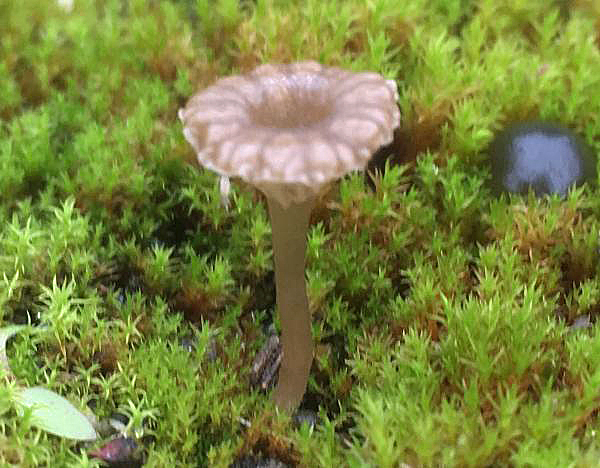
An attractive umbilicate mushroom, Arrhenia rickenii is most often seen growing in small groups in mossy places.
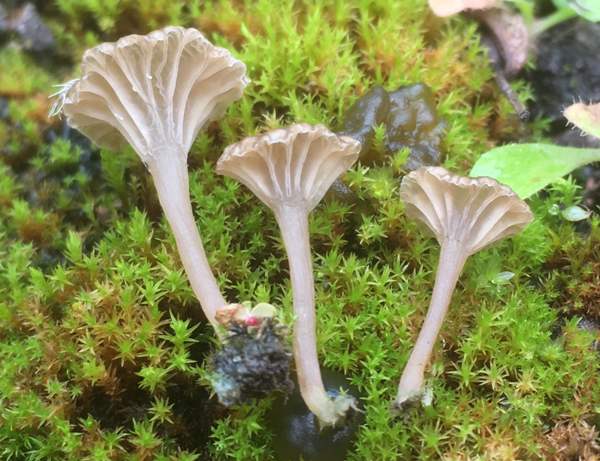
Distribution
In Britain and Ireland this is a rarely recorded species, probably due at least in part to its small size and the tendency to be obscured by mosses. This little mushroom occurs in many parts of mainland Europe from Scandinavia down to the Mediterranean region.
Taxonomic history
When British mycologist Frederick Bayard Hora (1908 - 1984) described this mushroom scientifically in 1960, he established its basionym, giving it the name Omphalina rickenii. In a 1989 publication, Roy Watling of the Royal Botanic Garden, Edinburgh, transferred this species to the genus Arrhenia, thus establishing its currently accepted scientific name.
Synonyms of Arrhenia rickenii include Cantharellus cupulatus Fr., Leptoglossum rickenii (Hora) Singer,
Leptotus rickenii Singer, Omphalia helvelloides Hora, Omphalina cupulata (Fr.) P. D. Orton, Omphalina rickenii Hora, and Phaeotellus rickenii (Hora) Bon.
Note: some authorities place this species in the family Hygrophoraceae.
Etymology
Unusually, both parts of this binomial refer to distinguished mycologists. The genus name Arrhenia honours Swedish botanist Johan Petter Arrhenius (1811 - 1899), while the specific epithet rickenii is in honur of German Roman Catholic priest and mycologist Adalbert Ricken (1851 - 1921).
The British Mycological Society has recently given this species a recommended English name: Moss Navel.
Identification guide
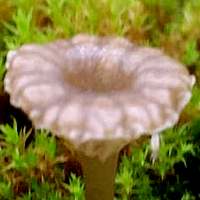 |
Cap
0.5 - 2.5cm in diameter when fully mature, the
cream-ochre caps are initially convex-umbilicate and later become more deeply funnelled with wavy incurved margins; lined almost to the centre; whitish at the edge and darker towards the middle; surface matt or very finely velvety. |
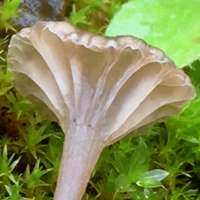 |
Gills
Very widely spaced and usually branching near the cap margin, often with net-like cross veins, the
decurrent gills are slightly paler than the cap surface.
Stem
1-2mm in diameter and 0.7 to 3cm long, usually narrowing to a blunt tip at the base, the centrally-situated stem is smooth and concolorous with the cap. |
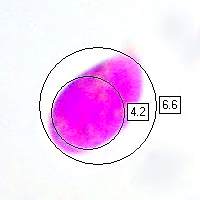 |
Spores
Ellipsoidal to dacryoid (tear-drop shaped), smooth, 6-9 x 3.5-5μm, inamyloid.
Spore print
White. |
Odour/taste |
Usually with a faint odour or pelargoniums; no significant taste. |
Habitat & Ecological role |
Saprophytic, nearly always on mosses on alkaline soil - for example in dune slacks or on unimproved grassland overlying calcareous rocks and sometimes on the moss-covered remains of old lime-rich walls. |
Season |
September to November in Britain and Ireland. |
Similar species |
Several similar Arrhenia species grow on moss, lichens or liverworts and microscopic examination is often necessary to separate some of them. |
Culinary Notes
These are insubstantial little mushrooms and of no culinary interest.
Reference Sources
Fascinated by Fungi, 2nd Edition, Pat O'Reilly 2016, reprinted by Coch-y-bonddu Books in 2022.
Kibby, G (2013) The Genus Tricholoma in Britain, published by Geoffrey Kibby
BMS List of English Names for Fungi
Dictionary of the Fungi; Paul M. Kirk, Paul F. Cannon, David W. Minter and J. A. Stalpers; CABI, 2008
Taxonomic history and synonym information on these pages is drawn from many sources but in particular from the British Mycological Society's GB Checklist of Fungi.
Acknowledgements
This page includes pictures kindly contributed by Simon Harding.
Top of page...
Fascinated by Fungi. Back by popular demand, Pat O'Reilly's best-selling 450-page hardback book is available now. The latest second edition was republished with a sparkling new cover design in September 2022 by Coch-y-Bonddu Books. Full details and copies are available from the publisher's online bookshop...